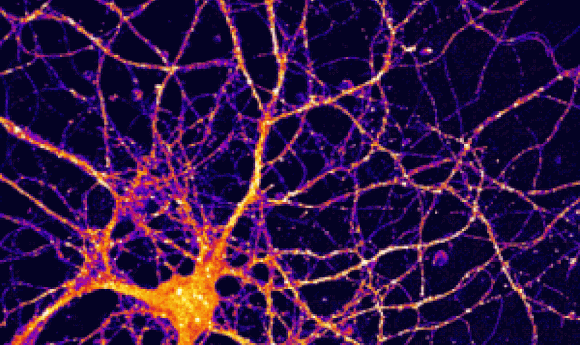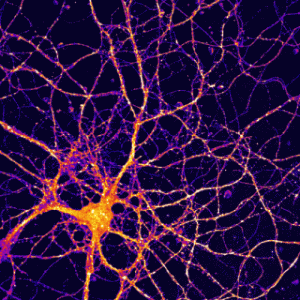The link between memory and viruses

Scientists discovered that a protein important for memory forms virus-like particles and transfers mRNA between cells.

Neuron showing Arc mRNA
Credit: Jason Shepherd, University of Utah School of Medicine
The brain extracts and interprets information from the world and outlines behavior and responses to external stimuli. It has an immense ability to learn and store information. The basis of this learning and memory is synaptic plasticity—the ability of connections between neurons to modify over time. One gene that controls this process is Arc.
First reported in 1995 by two independent groups as a gene induced in response to seizures in the hippocampus, Arc, or activity-regulated cytoskeleton-associated protein, has fascinated neuroscientists (1,2). It is essential for converting experiences into long-term memory. Disruption of Arc expression is associated with various neurological and neurodevelopmental disorders. Cells express Arc mRNA quickly—sometimes within 5 minutes—in response to synaptic activity or external stimulation. Once transcribed, Arc mRNA travels within an hour to the most distant tips of dendrites, the branched extensions of neurons, where it accumulates and undergoes translation (3).
Previous studies showed that the Arc sequence resembles that of the retroviral gene Gag, and that it originated from the Ty3/Gypsy retrotransposon family, an ancestor of retroviruses that became integrated into higher vertebrates (4-6). Further evidence of Arc’s viral origin emerged in 2015 when researchers reported the crystal structure of its subunits, which were similar to the capsid region of the human immunodeficiency virus (HIV) Gag protein (5, 6).
It is fascinating to think that such a crucial gene for memory and learning comes from ancient viruses, but what exactly is the role of those viral sequences in the function of Arc? Recently, two studies published in Cell showed that Arc actually forms retroviral-like capsid structures and transfers mRNA, including its own mRNA, between cells in the nervous system (7,8)
The Memory Virus
Jason Shepherd from the University of Utah, corresponding author of one of the Cell studies, has worked on Arc for most of his research career. “We tried to purify the protein, but it was not coming out as a monomer. We thought that it might be a sticky protein,” he said. “Then we did size exclusion chromatography and electron microscopy, and that’s when we were surprised to see that the protein is making all those structures, which were like viral capsids.”
His team further investigated Arc’s biochemistry by expressing it in cells that don’t normally contain Arc. They observed that just like purified Arc protein, Arc forms oligomers. They also found that Arc purified along with nucleic acids.
Since retroviral Gag protein binds its own mRNA and then gets encapsulated into capsids, Shepherd and his team hypothesized that Arc might also bind RNA and encapsulate it. To find out, they compared Arc mRNA levels in the purified Arc capsids with those of a highly abundant bacterial RNA. They found that Arc mRNA levels were 10-fold higher than the bacterial RNA in the capsids. Their results also indicate that Arc capsids are not very specific for any particular RNA.
To further prove that Arc mRNA is encapsulated in capsids, the authors treated the purified capsids with a RNA degrading enzyme. They found that the enzyme did not degrade Arc mRNA. These results indicate that Arc binds its own mRNA and other abundant RNAs and forms a complex (7).
Cell–cell Communication
Cells release small nano-sized, membrane-bound vesicles called extracellular vesicles (EVs) regularly, but the critical role of EVs in various normal physiological activities has only been recently described. EVs transport cargo such as proteins and nucleic acids between cells as part of their intercellular communication. EVs also resemble viruses—particularly retroviruses—in the way they are released from cells (9). The process of retroviral assembly and release is quite similar to the generation and release of EVs from cells, so similar in fact, that some scientists speculate that viruses hijacked the EV mechanism to use for their own advantage.
Shepherd and his team decided to further explore Arc’s viral connection by finding out if Arc is also released from the cells in the same way as viral capsids. For this, they harvested media from cells transfected with Arc and then purified the fraction containing EVs, where they detected both Arc mRNA and protein. The authors next repeated the same experiments in neurons collected from mouse and again observed Arc mRNA and protein in EV fractions.
Meanwhile, Travis Thomson a neurobiologist from the University of Massachusetts and his colleagues also observed that fruit fly Arc mRNA abounded in the EV fraction from cultured cells. Interested in learning about Arc’s role in maintaining synaptic plasticity, they turned to the junctions of motor neurons and muscle fibers in fruit fly larva. The team confirmed that Arc mRNA and protein were present at neuro-muscular junctions and that Arc protein complexes with Arc mRNA and assembles into a capsid-like structure.
From there, they learned that the Arc protein-mRNA complex is released from neurons in EVs and travels to the target muscle cell. This transfer is essential for synaptic plasticity at the junctions of nerve and muscles, and reducing Arc levels reduced the formation of new axon terminals or synaptic boutons.
“This shows a new way of cell-to-cell-communication,” said Shepherd. “Although viruses and retrotransposons are bad in the short term, they are providing new DNA elements in the long term.”
“The idea that the host has taken up a viral-like mechanism for communication is fascinating,” said Thomson. The expansion of genome sequencing over the last decade revealed that roughly half of the mammalian genome consists of DNA from transposon or viral origin. “We would like to know if there are any other genes that take viral like qualities for their function,” Thomson said. “And we still don’t know how Arc is involved in synaptic plasticity in a mechanistic way.”